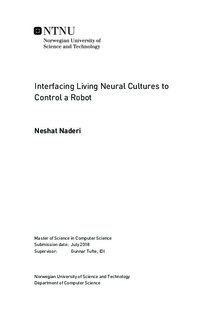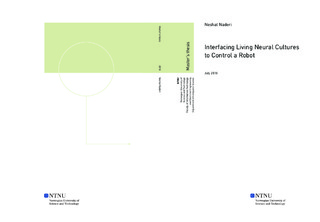| dc.contributor.advisor | Tufte, Gunnar | |
| dc.contributor.author | Naderi, Neshat | |
| dc.date.accessioned | 2019-09-11T10:56:24Z | |
| dc.date.available | 2019-09-11T10:56:24Z | |
| dc.date.created | 2018-07-19 | |
| dc.date.issued | 2018 | |
| dc.identifier | ntnudaim:19887 | |
| dc.identifier.uri | http://hdl.handle.net/11250/2615867 | |
| dc.description.abstract | The idea of benefiting from exceptional capabilities of human cognition has been the inspiration to construct a bio-robotic machine.The human brain is an adaptive complex system capable of performing heavy computations efficiently. Features such as adaptivity and energy efficiency found in biological systems are not present in today's computer technology. The potential of organic systems motivates the NTNU Cyborg project to build a hybrid machine by utilizing unconventional computation paradigms. One of the big challenges is to enable communication between the biological substrate and a digital robotic system.
In this thesis, we take the first step towards interfacing such a hybrid machine that opens the opportunity of integrating biological neural cultures into a mechanical-digital robot. The main goal is proving the functionality of a hypothetical hybrid machine that is constructed using Reservoir Computing methodology.
A functioning simulator is implemented as a close imitation of biological neural networks that is able to communicate with a Pepper robot; an off-the-shelf robot. The proposed architecture for this simulator contains three main parts. The first part is a Pepper robot that extracts sensor data from its environment, the second is a Reservoir Computing (RC) system that utilizes a Random Boolean Network (RBN) to interpret data input stimuli from the robot. The final part contains a controller that can stimulate the robot movements with predictions made by the reservoir system. All three sub-systems are integrated to enable an experimental approach to verify the proposed RC based hybrid cyborg.
The simulator is a functioning system capable of creating dynamics in a digital reservoir, responsive to the external perturbation made by the robot sensory information. Further it can interpret the dynamical changes in the RBN reservoir and pass it as a projection of the original input into a higher dimensional feature space. These new features are used as training data for a linear classification model to predict the robot movements.
Despite the real-world challenges, e.g. noise and non-determinism, the experimental results show that the proposed RC-neuron-robot approach is a sound way toward achieving the goal of the NTNU Cyborg project. | en |
| dc.language | eng | |
| dc.publisher | NTNU | |
| dc.subject | Datateknologi, Algoritmer og HPC | en |
| dc.title | Interfacing Living Neural Cultures to Control a Robot | en |
| dc.type | Master thesis | en |
| dc.source.pagenumber | 60 | |
| dc.contributor.department | Norges teknisk-naturvitenskapelige universitet, Fakultet for informasjonsteknologi og elektroteknikk,Institutt for datateknologi og informatikk | nb_NO |

